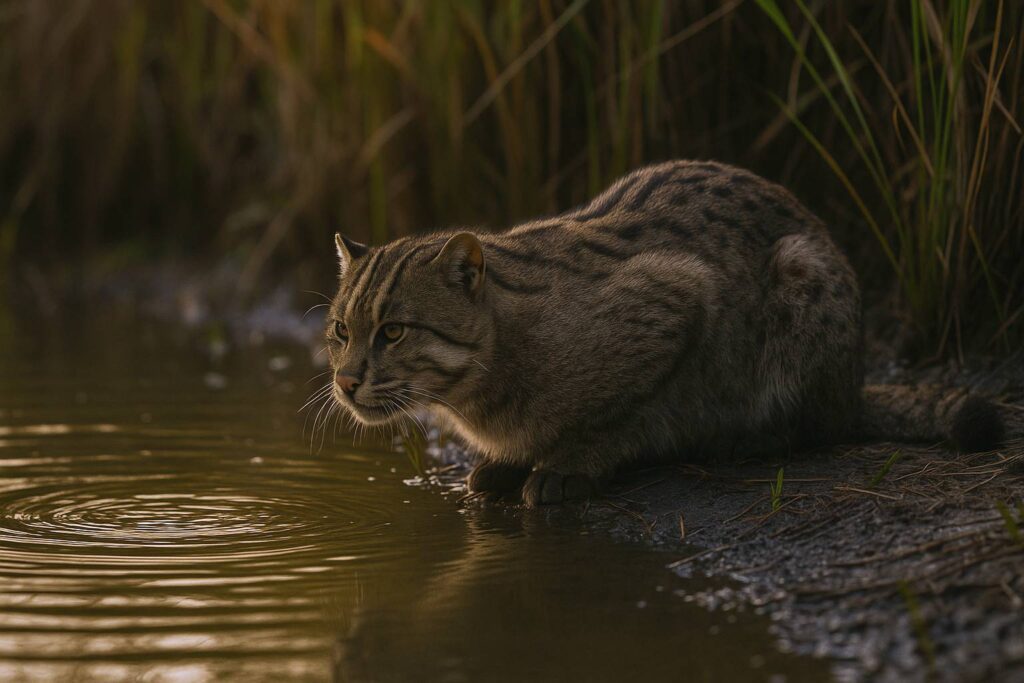
Hidden in India’s wetlands, mangroves, and riverbanks prowls a cat that many don’t know: the Fishing Cat (Prionailurus viverrinus). Adapted to life in watery landscapes, masters of stealth and swimming, fishing cats are elusive yet vital members of India’s wildlife. As their habitats vanish, their stories demand attention.
What Is a Fishing Cat?
- The fishing cat is a medium-sized wild cat found in South and Southeast Asia.
- Fur color is yellowish-grey to tawny, with dark stripes and spots. Their ears are rounded. They are excellent swimmers and hunters in aquatic settings.
- Unlike many cats, the fishing cat loves water: it swims, dives, and hunts fish, rodents, birds, and small reptiles near or in water bodies.
Where Do They Live in India?
- Fishing cats are mostly found in wetlands: mangroves, marshes, mangrove creeks, swamps, and along slow-moving rivers and streams.
- Key areas in India with confirmed populations include the Sundarbans, Odisha’s Bhitarkanika, wetlands in Andhra Pradesh, and the Ganga-Brahmaputra delta.
Unique Adaptations & Behavior
- Webbed front paws, thick dense fur that resists water, and the ability to close ears when underwater help them swim and hunt in aquatic environments.
- Mostly nocturnal, but sometimes active during twilight. They often hunt at night or early morning.
- Solitary animals. Adult males and females have separate home ranges; females overlap with males during mating seasons.
Conservation Status & Threats
- The IUCN Red List classifies the fishing cat as Vulnerable globally. The population is estimated to have declined by about 30% over recent generations.
- Major threats:
- Habitat loss & degradation — wetlands are drained for agriculture, urban development, and aquaculture.
- Conflict with humans — when they enter farms, poultry areas, or fish ponds, they are sometimes killed in retaliation.
- Decline in prey — overfishing and pollution reduce food availability.
- Roadkills and poaching — accidents and hunting for skin in some regions.
Conservation Efforts & Hope
- Several NGOs and wildlife groups emphasize wetland protection, community education, and awareness under the Fishing Cat Conservation Alliance.
- Surveys and camera-trap studies in states like Assam and West Bengal help map populations and understand behavior.
- Legal protections: in India, fishing cats are listed under the Wildlife Protection Act (Schedule I), which prohibits hunting.
Quick Facts
- Scientific name: Prionailurus viverrinus
- IUCN Status: Vulnerable
- Habitat: Wetlands, mangroves, marshes, riversides
- Diet: Fish (mainly), birds, rodents, reptiles near water
- Behavior: Mostly nocturnal, excellent swimmer, solitary
FAQs
Are fishing cats dangerous to people?
No. They are shy and avoid humans. They may raid poultry or fish ponds, but direct attacks on humans are extremely rare.
Is it possible to see a fishing cat in the wild?
Yes, but sightings are rare. They are secretive and mostly active at night, making them hard to spot.
Can people help fishing cats?
Yes. Supporting wetland protection, spreading awareness among local communities, avoiding pollution, and backing conservation projects all contribute to their survival.
Conclusion
The Fishing Cat is a powerful reminder of the beauty and fragility of India’s wetland ecosystems. Though vulnerable, its survival depends not just on laws and protected areas, but on awareness, kindness, and community effort. As wetlands vanish, we lose more than water — we lose species like this swamp specialist that ties life to the edge of water.


